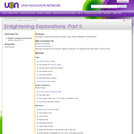
This lesson contains three student activities: Light, Angle of Reflection, and Refraction.
- Subject:
- Arts and Humanities
- Material Type:
- Activity/Lab
- Lesson Plan
- Provider:
- Utah Education Network
- Date Added:
- 08/12/2013

This lesson contains three student activities: Light, Angle of Reflection, and Refraction.
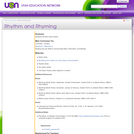
In this lesson students will learn about rhythm.
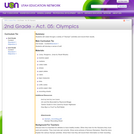
In this lesson students will rotate through a variety of "Olympic" activities and record their results.
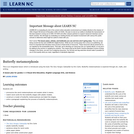
This is an integrated lesson which is introduced using the book "The Very Hungry Caterpillar" by Eric Carle. Butterfly metamorphosis is explored through art, math, and writing.

This course examines contemporary and historical cultural production on and from Africa across a range of registers, including literary, musical and visual arts, material culture, and science and technology. It employs key theoretical concepts from anthropology and social theory to analyze these forms and phenomena. It also uses case studies to consider how Africa articulates its place in, and relationship to, the world through creative practices. Discussion topics are largely drawn from Francophone and sub-Saharan Africa, but also from throughout the continent and the African diaspora.
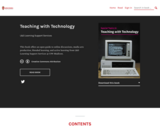
Short Description:
This book offers an open guide to online discussions, media arts production, blended learning, and active learning from L&S Learning Support Services @ UW-Madison.
Long Description:
This book offers an open guide to online discussions, media arts production, blended learning, and active learning from L&S Learning Support Services @ UW-Madison. It was first published in 2015 to accompany an online professional development course provided by LSS.
Word Count: 35588
(Note: This resource's metadata has been created automatically by reformatting and/or combining the information that the author initially provided as part of a bulk import process.)

Using the web-based lessons highlighted in this article, students learn how to pose questions before, during, and after reading nonfiction, fiction, and diagrams. This reading comprehension strategy is included in the literacy column of the magazine Beyond Weather and the Water Cycle, a free, online publication for K-5 teachers.
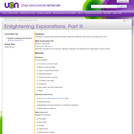
This lesson contains three student activities: Rainbows, Refraction with Prisms, and What Color Is It?
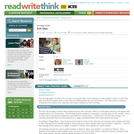
This strategy guide introduces the concept of using Exit Slips in the classroom to help students reflect on what they have learned and express what or how they are thinking about the new information. Exit Slips easily incorporate writing into the content area classroom and require students to think critically.
The Exit Slip strategy is used to help students process new concepts, reflect on information learned, and express their thoughts about new information. This strategy requires students to respond to a prompt given by the teacher, and is an easy way to incorporate writing into many different content areas. Furthermore, the Exit Slip strategy is an informal assessment that will allow educators to adapt and differentiate their planning and instruction.
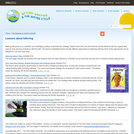
Different approaches to teaching the reading comprehension strategy of inferring in K-5 classrooms are identified in this article. The article appears in the free, online magazine Beyond Weather and the Water Cycle, which is structured around the essential principles of climate science.

This OER Myths and Legends was created by Yulia Evans as part of the 2024 World Language OER Summer work and training. Educators worked with Chrystal Liu, Nick Ziegler and Dorann Avey to create OER Learning Plans and materials. The attached Lesson Plan “Bremer Stadtmusikanten” is designed for 9 - 12 World Language Arts teachers for Novice Learners of German. Students will interpret the video, analyze the plot and be able to retell the story in German. This Lesson Plan addresses the following NDE World Language Standard(s): NE WL 1.1, 1.2, 1.3, 2.1b, 4.2aIt is expected that this Lesson Plan will take students 50 minutes to complete.

How do I motivate my students to create their own original art work? How to I get my students to start thinking creatively? I have used I See, Wonder and Think activity combined with three ways to think about art as a spring board for motivating students. Imitationalism: This is a belief that art work should be made to represent what we see in the real world. Sometimes it is also referred to as Realism.Formalism: This is the belief that art work should focus on the Language of Art. The artist focus is on using the Elements of Art and the Principles of design as the main focus of the art work. Sometimes referred to as the form, or formal aspects of the work.Emotionalism: This is the belief that art work should express the artist emotion or create an emotional reaction or response from the viewer. This is some times referred to as expressionistic.
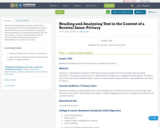
This lesson is designed for students in adult basic education grade level E (low and high adult secondary education). The purpose of this lesson is to develop student proficiency in reading and analyzing text. The lesson topic is the issue of an individual’s right to privacy as balanced with the government’s responsibility for security of its citizens.
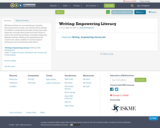
Writing activities are an essential part of quality literacy practices in early care and education settings. As children communicate through writing, they learn important concepts about books and other forms of print in the world around them, including writing and alphabet systems. Writing, like speaking and the creative arts, allows children to actively express themselves and communicate with others.
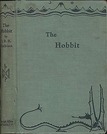
This Remote Learning Plan was created by Tami Hughson in collaboration with Dorann Avey as part of the 2020 ESU-NDE Remote Learning Plan Project. Educators worked with coaches to create Remote Learning Plans as a result of the COVID-19 pandemic.The attached Remote Learning Plan is designed for Grade 7 English Language Arts students. Students will explore and identify rules for correct punctuation of dialogue. They will write a short dialogue and apply the rules for correct formatting.This Remote Learning Plan addresses the following NDE Standard: NE LA 7.2.1 HIt is expected that this Remote Learning Plan will take students 60-90 minutes to complete.
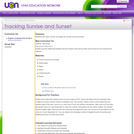
In this lesson students will collect, record, and graph the sunrise and sunset times.

Welcome to the first, biannual Archival Educators Roundtable (AER) Newsletter! In 2016, the Rockefeller Archive Center (RAC) brought together like-minded professionals who use primary sources for public programming, outreach, and education, and the AER was born. As archival education is a still-developing field, the AER created a community where people could share their successes, challenges, and works in progress through casual workshops.AER’s network of educators, archivists, and archival education allies has since expanded its culture of support beyond the biannual meetings here at the RAC through social media, event attendance, joint publications, and email correspondence.It is our hope that this AER Newsletter will further extend the table, so speak, reaching more colleagues as we spotlight educators, and showcase the projects, challenges, and successes of archival education. Just as the aim of AER meetings is to ensure that all perspectives on primary source education are honored, we encourage you, our dedicated AER audience, to reach out and contribute your insights to future AER Newsletters! Many thanks to our first issue's contributors--we couldn't have done it without you.--Marissa Vassari, Archivist and Educator, Rockefeller Archive CenterElizabeth Berkowitz, Outreach Program Manager, Rockefeller Archive Center
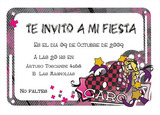
This OER Spanish Invitation was created by Danielle Fulcher and as part of the 2024 World Language OER Summer work and training. Educators worked with Chrystal Liu, Nick Ziegler and Dorann Avey to create OER Learning Plans and materials. The attached Lesson Plan is designed for 9 - 12 World Language Arts teachers for student learning of Mid Novice Learners of Spanish. Students will write their own invitation to an event. After writing their invitations, they will do an interpersonal activity in which they extend invitations to their classmates. This activity addresses the following NDE World Language Standard(s): NE LA 12.1.6b, NE LA 12.1.6l, and NE LA 12.1.6oIt is expected that this activity will take students 90 minutes to complete.

Activities For Post-Secondary Educators and Students
Short Description:
Drawing in class is often seen as a distraction to learning. We are here to change that, with a series of activities designed to get both students and teachers benefiting from the power of visual thinking through drawing.
Long Description:
Communicating visually, through drawing, is a core practice to many fields and endeavors. However, in the world of post-secondary educators, it can be seen as fraught with peril. The barrier of one’s perceived drawing ability, on top of managing a lecture or facilitating a discussion, often means educators are hesitant to take advantage of a visual practice to its most benefit. This is a missed opportunity, but the situation is changing. More people are realizing the power of drawing as an extension of thinking, taking advantage of how the act of drawing generates new ideas and reveals unseen connections.
Quite simply, Drawing in the Classroom, generates learning.
Word Count: 4557
(Note: This resource's metadata has been created automatically by reformatting and/or combining the information that the author initially provided as part of a bulk import process.)

Students will research how the development of the atomic bomb affected people in World War II, participate in a debate about the bomb's use, and investigate how it has affected people's lives since 1945.